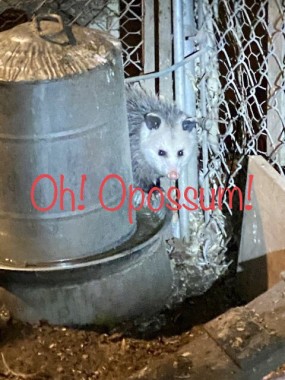
February brings thoughts of love, so this post gives some adoration to an often misunderstood creature. Come meet my recent “visitor”!
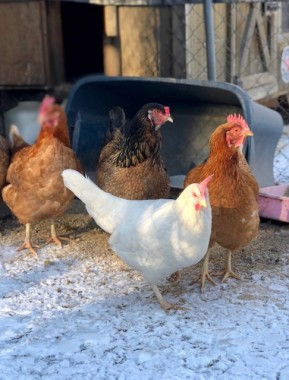
Recently, we had a breach in “Foul Knox”, our chicken run. It was a not-too-cold evening, and we were taking our dogs out before heading to bed. Odin, our large brindle hound, started “pointing” at the hen house. Something was inside the run! We put the dogs inside and grabbed a flashlight, fearing a raccoon or fox had infiltrated the coop. However, inside the run was the cutest, fluffiest, round fuzzy opossum!
I wasn’t too concerned for my chickens; I’d locked up the henhouse earlier. The visitor was small and young. It wasn’t fearful of us, but more interested, or curious.
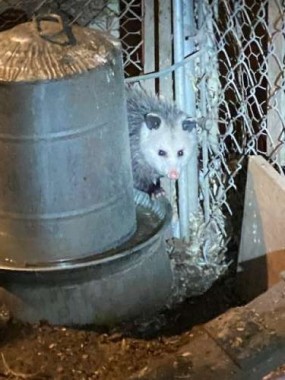
It peeked out from behind the waterer, then scaled the back fence, a very agile climber. It looked a bit confused, like it wasn’t sure how to get back out or why we were there.
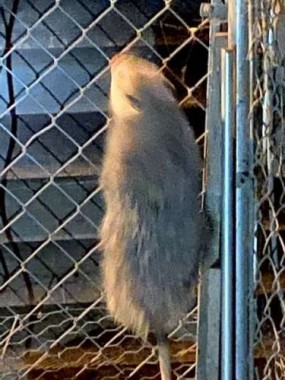
I keep a small radio playing inside the run, the idea that the sound of voices keep predators away. I’ve often wondered how the channel changes overnight when I return in the morning to open the henhouse. Mystery solved – the opossum decided to lounge across the radio awhile, changing the channel from the “lite” station when it climbed on top. Maybe I should switch to heavy metal!
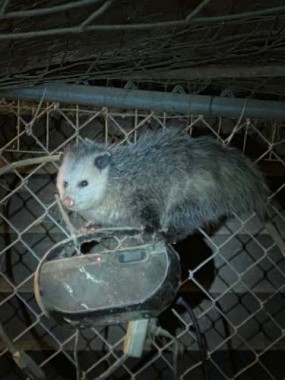
Apparently, my visitor is a Debbie Gibson fan.
We left the big gate open, checking often to see if the opossum had left. When we returned, it walked over, climbing the inside of the front fence. It never showed its teeth or hissed. (We were always on the other side of the fence, at a safe distance).
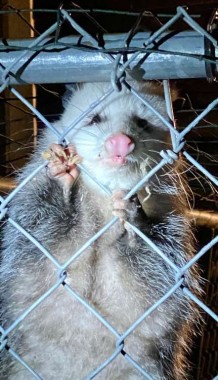
OH! That face…so cute.
It was so fuzzy, with thick soft-looking grey fur, an adorable face with a pink button nose, and cute little ears and paws with opposable thumbs. I was smitten.
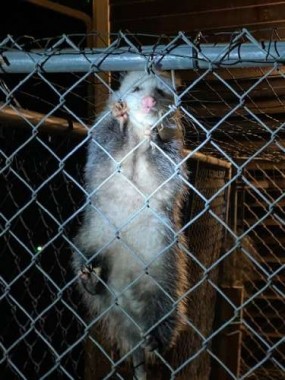
“It’s so FLUFFY!!!”
The next morning, our furry friend had departed. I was shocked by how many people don’t like opossums, suggesting it should be trapped or killed, that it’d kill my chickens, carried rabies, or was an overgrown rodent. I decided to find out the true facts.
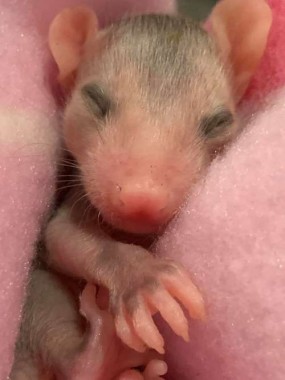
Photo courtesy Stephanie Safarik
Stephanie Safarik, a well-known wildlife rehabilitator, is an angel for opossums. She had always worked with animals, and wanted to be a vet, but her life changed course. Seven years ago, she says her health “failed miserably, with a perfect storm of disaster”. With a cancer diagnosis and facing several surgeries, life was going to be at a slower pace for awhile. She’d always wanted to be a wildlife rehabber, so she decided to see what was needed to follow that dream, thinking, “Maybe while I’m in recovery, a couple animals can be rehabilitated, too”. Through the Connecticut DEEP, she took the course, received veterinarian backing, mentored with an experienced rehabilitator, completed the needed state application to work with wildlife, and created a haven for sheltering animals to recover. She didn’t expect to become the “opossum person”, but is thrilled to give a voice to these docile, often misunderstood creatures. Stephanie says nowadays her health’s not completely ideal, but is much better, crediting the opossums she saved with her improvement. They pushed her- when she wanted to stop she couldn’t because she had little lives depending on her. First working with three baby opossums whose mom was hit by a car, Stephanie has now saved a few hundred opossums.
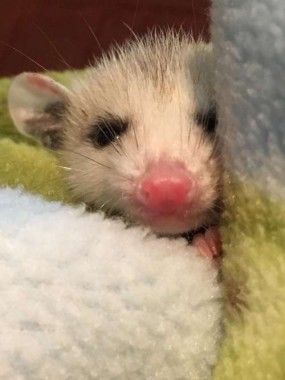
Photo courtesy of Stephanie Safarik
While there are 100 opossum species worldwide, in the USA, we have the Virginia Opossum. Opossums are not rodents, but the only marsupials found in North America, carrying their babies in a fur-lined pouch. Calling these critters “possum” is also a misnomer; a “possum” is an animal of a different species found in Australia.
Stephanie says opossums will try to avoid people at all costs. Opossums are often mistakenly blamed for the havoc that clever raccoons wreak. Our visitor probably came before, as opossums tend to keep to a “routine”.
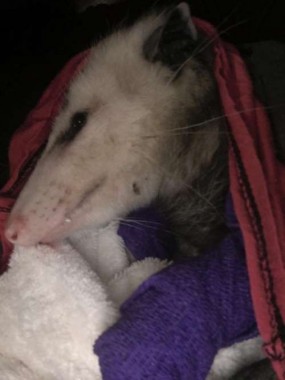
“Why, what a big mouth you have…”
Photo courtesy Stephanie Safarik
While they have large mouths with fifty sharp teeth, they rarely kill prey like chickens, unless they’re starving. They prefer “easy” meals, such as eggs and dropped, rotting fruit from trees. They don’t kill for sport. When wildlife comes into our yards, we shouldn’t be upset; it’s our responsibility to protect our domestic animals. I’m actually grateful having learned that my chicken run had a weak spot.
Opossums are the “waste management” of nature, keeping “rot” down by eating dropped fruit or carnage. They’re also the only truly “natural” defense against ticks. My whole family, including one of our dogs, has been affected by tick-borne illness. Opossums are cat-like in that they groom themselves often (why our visitor was so fluffy)! Because they’re low, with their little tummies touching the ground when they walk, they’re “tick magnets”. They then ingest hundreds of ticks (part of their nutrition) when grooming, thus keeping Lyme disease down. They also eat mice, rats and insects such as beetles.
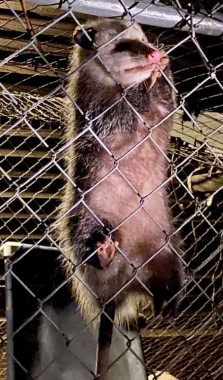
An opossum prefers to flee than to fight. They’ll defend themselves if cornered, hissing, showing the fifty teeth in their big mouths, and releasing an odor (like a dog’s anal gland odor). Finally, they’ll “play dead”, actually an involuntary action. The frightened opossum will fall over in a comatose state, like in shock; its heart rate goes down, and it mimics the scent of a dead animal. This can last for an hour.
Opossums rarely get rabies. In Connecticut, they’re not even considered a rabies vector, as a healthy opossum’s normal body temperature is actually too low for rabies to breed. For an opossum to contract rabies, it has to be a “perfect storm”: they must be sick with a fever to raise their body temp, be attacked by a rabid animal, and then survive said attack.
Opossums, however, unfortunately do not have long lives; males live an average natural lifespan of two years, and females two to four. A full-grown opossum reaches 7 – 8 pounds.
Though it’s speculated they’ve been around since dinosaurs roamed the earth, these little “underdogs” were not meant for cold conditions, even though they can be found as far North as Canada.
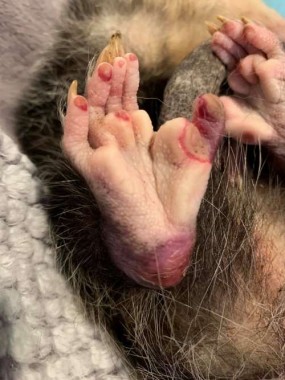
These feet are not meant for winter!
Photo courtesy Stephanie Safarik
Often developing frostbite on their hairless tails, paws, and paper-thin ears, many opossums die in winter, especially if under five pounds. Others are hit by cars or attacked by larger animals.
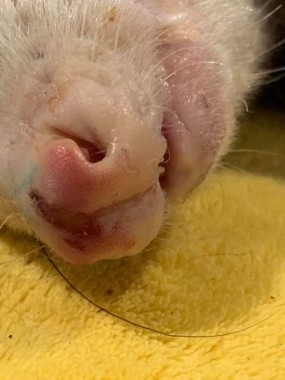
A poor frost bitten nose…
Photo courtesy Stephanie Safarik
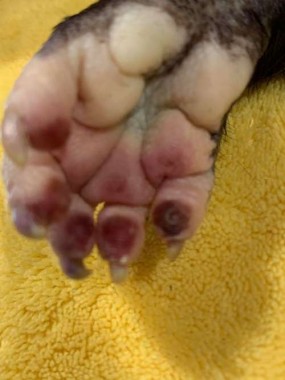
Ouch! Frostbitten paw.
Photo courtesy Stephanie Safarik
How do you know if you need to call a professional wildlife rehabber like Stephanie? If an opossum is orphaned, sick, injured, or has flies buzzing around it, call a wildlife rehabilitator. If an opossum is circling, it may have head trauma from being clipped by a car.
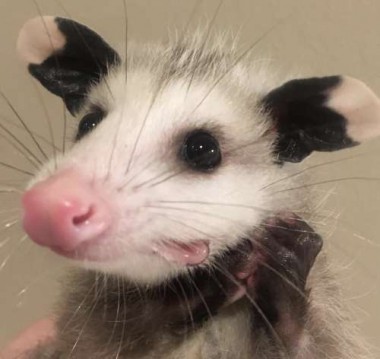
Photo courtesy Stephanie Safarik
An opossum has 13 nipples inside her pouch, and can give birth up to 20 babies at a time, though not all usually survive.
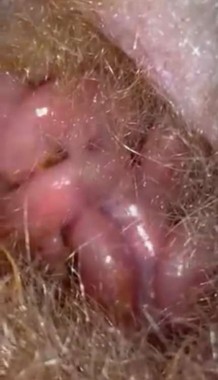
“New” babies, or “pinkies”
Photo courtesy of Stephanie Safarik
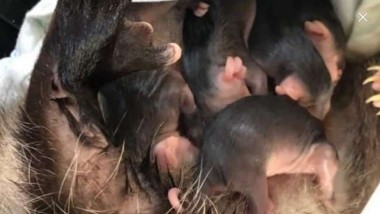
Warm and safe in Mama’s Pouch.
Photo courtesy Stephanie Safarik
Found babies, or babies whose mama has passed (they can live up to a day and a half in the pouch after the death of the mom) always need a rehabber. While they’re good mamas, they won’t come back for a baby the way a mama squirrel will. With so many babies riding on her back, Mama Opossum may not even realize she’s dropped one!
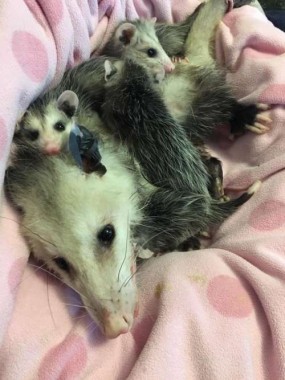
”Motherhood can be exhausting!”
Photo courtesy Stephanie Safarik
A spotted opossum, like most wildlife, really just wants to be left alone and do you no harm. If you do see one, let it be. “Cat shelters” can provide a warm place for them to avoid frostbite, and leaving scrap fruit or veggies out, especially in winter, is okay. They need lots of calcium, so hard boiled eggs with the shell on, cut in half are a great snack, too.
*** Follow Stephanie and her sweet rescues on Facebook at Persevering for Wildlife.
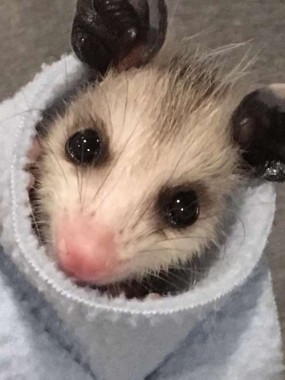
Photo courtesy Stephanie Safarik
As for our little visitor, we see an opossum every once in awhile in the driveway, though not since our last encounter. I hope we see “Radio” again soon.
Wishing everyone a very Happy Valentine’s Day! Drop by again for the next Suburban Farmgirl Blog, “live” March 17th.
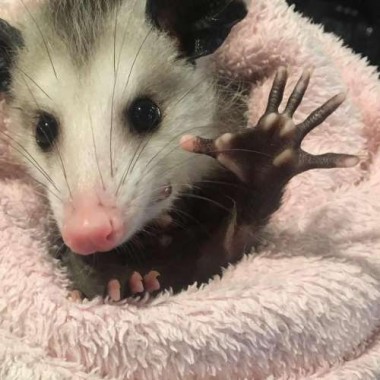
Please remember to leave a comment below so we know you dropped by! Photo courtesy Stephanie Safarik
Until Next Time…Farmgirl Hugs,
Nicole
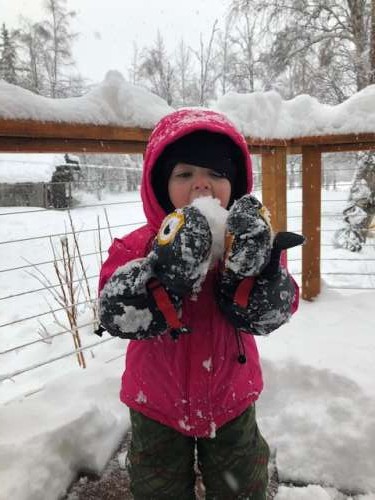


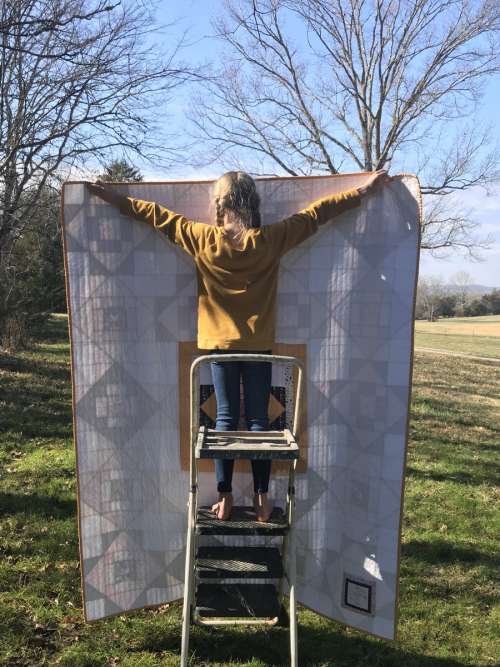




















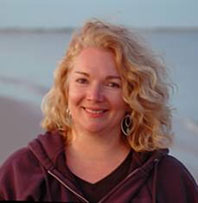


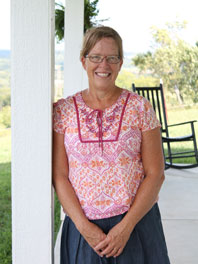
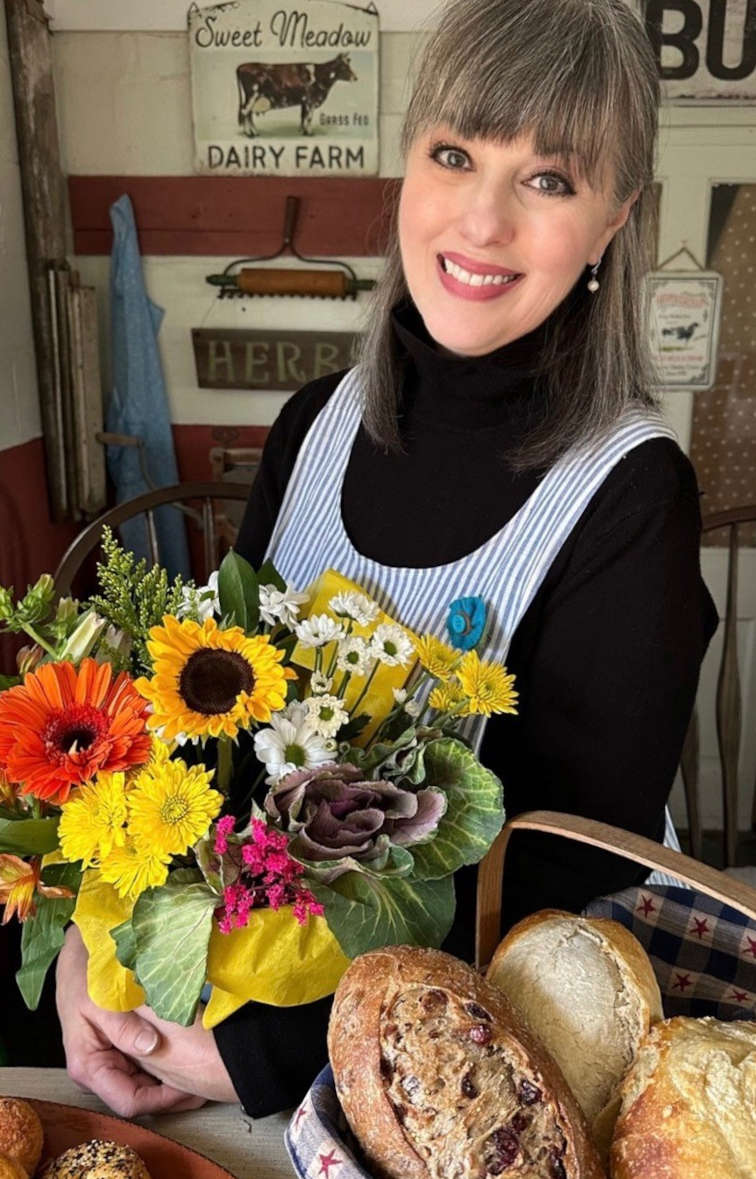
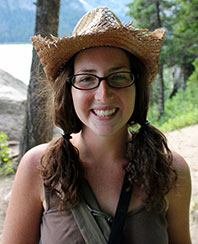
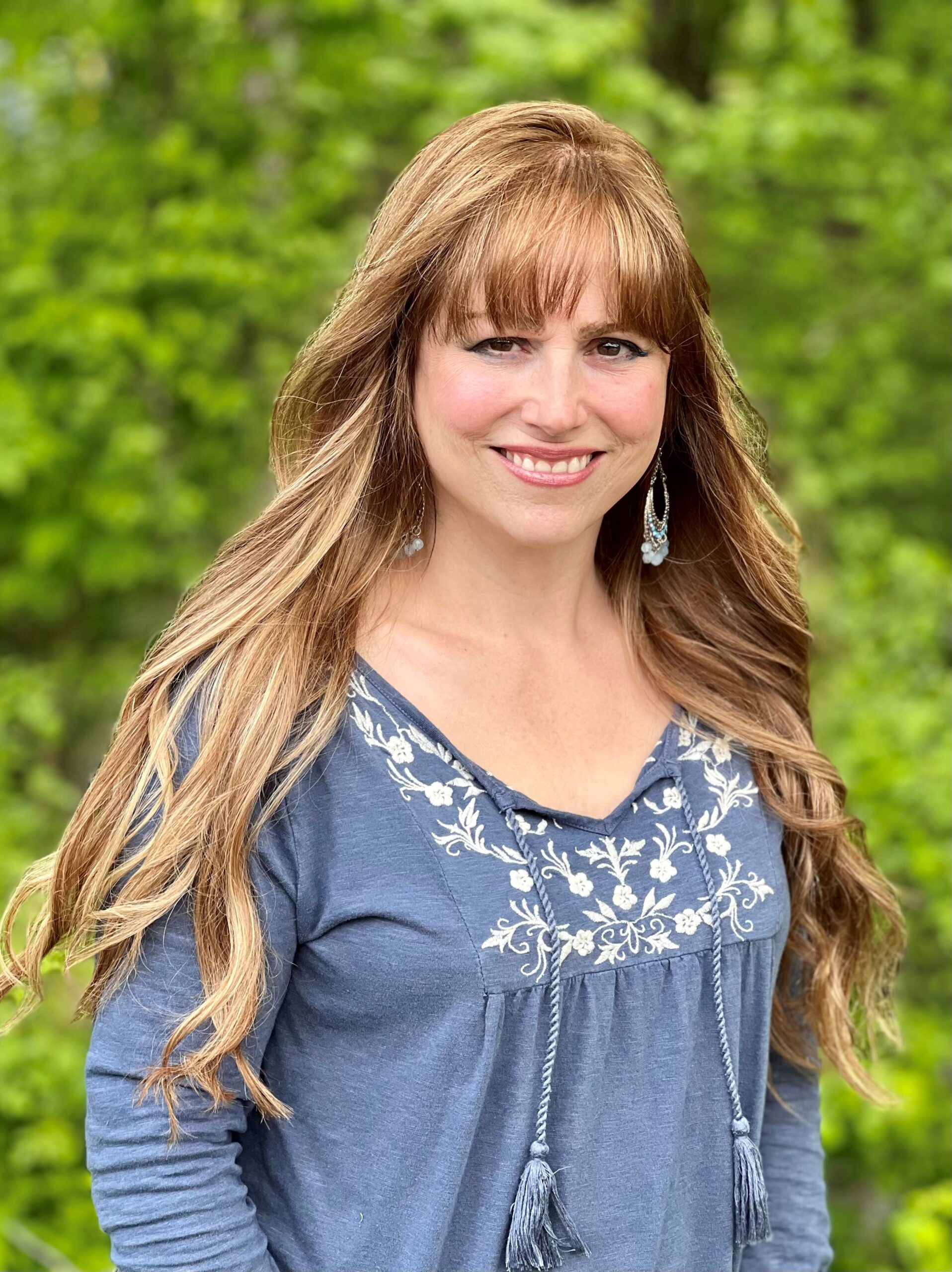


Weekly Blogs and Recipes